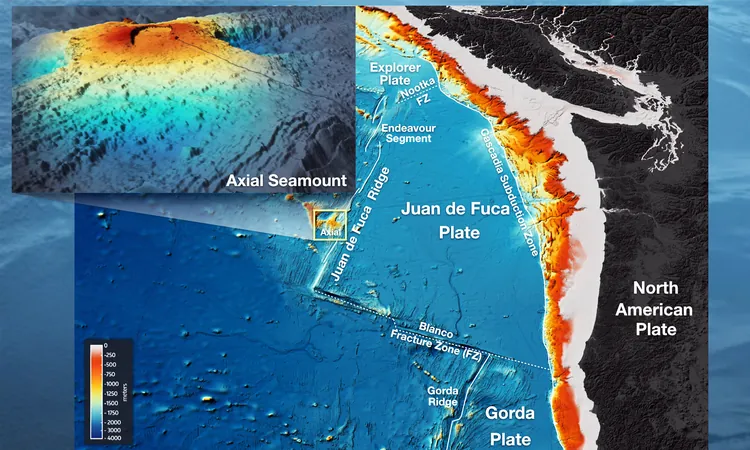
Underwater Volcano Off the US Coast on the Brink of Eruption!
2025-01-01
Author: Yan
Underwater Volcano Off the US Coast on the Brink of Eruption!
Deep beneath the Pacific Ocean, approximately 300 miles off the U.S. coastline, lies the Axial Seamount—a colossal underwater volcano that scientists warn may erupt at any moment. Since 1997, a dedicated team of researchers has monitored this geological giant using advanced tools to track pressure changes on the ocean floor, revealing concerning signs of impending activity.
Recent data indicates that Axial Seamount is experiencing notable inflation, with rapid swelling suggesting an eruption may be on the horizon. Alarmingly, the rate of this inflation increased dramatically in late 2023, accelerating to an astonishing 10 inches per year by mid-2024. In conjunction with this swelling, daily earthquake occurrences surged into the hundreds, signaling heightened volcanic activity.
Mark Zumberge, a geophysicist at the Scripps Institution of Oceanography, regards Axial Seamount as “the most well-instrumented submarine volcano on the planet.” The volcano sits atop the Juan de Fuca Ridge, an extensive underwater mountain range formed by tectonic plates pulling apart, allowing magma to surface and create new crust. This geological activity results in frequent eruptions, giving scientists a rare opportunity to closely observe volcanic processes in real-time, unlike most terrestrial studies which rely on ancient rock evidence.
Historically, Axial Seamount has exhibited consistent patterns prior to eruptions. Scientists have noted that current inflation levels mirror those seen before previous eruptions, raising the possibility of another explosive event by the end of 2025. Researchers are meticulously studying these patterns to improve eruption predictions, building a better understanding of what signals indicate magma movement within the volcano.
The effects of volcanoes extend beyond mere eruptions. Hydrothermal vents associated with Axial Seamount shape unique marine ecosystems, supporting specialized organisms such as tube worms and clams that thrive in the seafloor’s harsh, dark environments. These biological communities serve as a testament to the life-giving potential of volcanic activity, showcasing nature’s resilience.
Advancements in technology, including machine learning, are improving eruption forecasting capabilities. Experts analyze historical earthquake patterns to identify subtle cues that precede volcanic activity. As the inflation accelerates, real-time data tracking may allow scientists to pinpoint the exact moment when magma approaches the surface—transforming our understanding of underwater volcanology.
The significance of underwater eruptions transcends their immediate surroundings. The 2022 Hunga Tonga eruption, for example, resulted in a massive tsunami causing over $90 billion in damages worldwide. While Axial Seamount poses a lesser threat due to its location and the nature of its eruptions, the insights gleaned here could provide crucial information for predicting more hazardous volcanic activity elsewhere.
By refining forecasting models using real-time data from Axial, researchers aim to enhance disaster preparedness not only in the U.S. but globally. Continuous monitoring allows scientists to detect changes that could signal greater risks in future eruptions, facilitating timely evacuations and protective measures if necessary.
Each eruption at Axial serves as a unique case study, contributing valuable data vital for understanding the mechanics of volcanic activity. This underwater volcano provides scientists with a controlled environment to observe eruption patterns, leading to breakthroughs in predictive science.
In conclusion, Axial Seamount stands as a pivotal natural laboratory for volcanologists, offering unprecedented opportunities to study submarine eruptions. With advancements in technology and data analysis, the expectation of its next eruption inspires ongoing research that could reshape our understanding of volcanic forecasting and global safety measures.
Stay tuned, as experts track the globe's most-watched underwater volcano!


 Brasil (PT)
Brasil (PT)
 Canada (EN)
Canada (EN)
 Chile (ES)
Chile (ES)
 Česko (CS)
Česko (CS)
 대한민국 (KO)
대한민국 (KO)
 España (ES)
España (ES)
 France (FR)
France (FR)
 Hong Kong (EN)
Hong Kong (EN)
 Italia (IT)
Italia (IT)
 日本 (JA)
日本 (JA)
 Magyarország (HU)
Magyarország (HU)
 Norge (NO)
Norge (NO)
 Polska (PL)
Polska (PL)
 Schweiz (DE)
Schweiz (DE)
 Singapore (EN)
Singapore (EN)
 Sverige (SV)
Sverige (SV)
 Suomi (FI)
Suomi (FI)
 Türkiye (TR)
Türkiye (TR)
 الإمارات العربية المتحدة (AR)
الإمارات العربية المتحدة (AR)